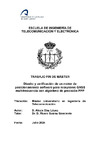Identificador persistente para citar o vincular este elemento:
https://accedacris.ulpgc.es/jspui/handle/10553/132260
| Campo DC | Valor | idioma |
|---|---|---|
| dc.contributor.advisor | Suárez Sarmiento, Álvaro | - |
| dc.contributor.author | Díaz López, Alexis | - |
| dc.date.accessioned | 2024-07-21T20:01:24Z | - |
| dc.date.available | 2024-07-21T20:01:24Z | - |
| dc.date.issued | 2024 | en_US |
| dc.identifier.other | Gestión académica | - |
| dc.identifier.uri | https://accedacris.ulpgc.es/handle/10553/132260 | - |
| dc.description.abstract | Actualmente, la tecnología Global Navigation Satellite System tiene una importancia crucial para cualquier proyecto o desarrollo de producto que conlleve aplicaciones de posicionamiento o navegación. Entre las diferentes aplicaciones posibles, existen aplicaciones como arquitectura de precisión, topografía y cartografía de alta precisión, sistemas de navegación para vehículos autónomos, entre otras, que requieren de una precisión al nivel de centímetros o incluso milímetros de error en la posición. Como solución a este problema, surgen las correcciones Precise Point Positioning, las cuales ofrecen correcciones precisas a las diferentes fuentes de error que afectan a las medidas utilizadas para el cálculo del posicionamiento de los usuarios. El objetivo principal del presente Trabajo Fin de Máster consiste en desarrollar un motor de posicionamiento software con correcciones Precise Point Positioning para usuarios multifrecuencia y evaluar su rendimiento mediante métricas estadísticas. En primer lugar, se realiza un estudio en profundidad de la teoría y tecnologías relacionadas necesarias para el desarrollo del proyecto. En segundo lugar, se define los requisitos que debe cumplir el sistema a desarrollar junto con los casos de usuario englobando el escenario de datos a utilizar y los modelos a implementar. En tercer lugar, se desarrolla el software aplicando todas las implementaciones, algoritmos y modelos matemáticos necesarios para el desarrollo completo del sistema. Finalmente, se verifica el rendimiento y funcionamiento de la herramienta desarrollada mediante métricas estadísticas en la comprobación de la solución de posicionamiento con la posición exacta de referencia de varios receptores desplegados en diferentes localizaciones. | en_US |
| dc.description.abstract | Currently, Global Navigation Satellite System technology is of crucial importance for any project or product development involving positioning or navigation applications. Among the different possible applications, there are applications such as precision architecture, high-precision topography and cartography, navigation systems for autonomous vehicles, among others, which require precision to the level of centimetres or even millimetres of error in position. As a solution to this problem, Precise Point Positioning corrections arise, which offer precise corrections to the different sources of error that affect the measurements used to calculate the positioning of users. The main objective of this Master's Thesis is to develop a software positioning engine with Precise Point Positioning corrections for multi-frequency users and to evaluate its performance using statistical metrics. Firstly, an in-depth study of the theory and related technologies necessary for the development of the project will be carried out. Secondly, the requirements to be met by the system to be developed will be defined together with the user cases encompassing the data scenario to be used and the models to be implemented. Thirdly, the software will be developed by applying all the implementations, algorithms and mathematical models necessary for the complete development of the system. Finally, the performance and operation of the developed tool will be verified by means of statistical metrics in the verification of the positioning solution with the exact reference position of several receivers deployed in different locations. | en_US |
| dc.language | spa | en_US |
| dc.subject | 3325 Tecnología de las telecomunicaciones | en_US |
| dc.title | Diseño Y Verificacion De Un Motor De Posicionamiento Software Para Receptores Gnss Multifrecuencia Con Algoritmo De Precision Ppp | en_US |
| dc.type | info:eu-repo/semantics/masterThesis | en_US |
| dc.type | MasterThesis | en_US |
| dc.contributor.departamento | Departamento de Ingeniería Telemática | en_US |
| dc.contributor.facultad | Escuela de Ingeniería de Telecomunicación y Electrónica | en_US |
| dc.investigacion | Ingeniería y Arquitectura | en_US |
| dc.type2 | Trabajo final de máster | en_US |
| dc.utils.revision | Sí | en_US |
| dc.identifier.matricula | TFT-24662 | - |
| dc.identifier.ulpgc | Sí | en_US |
| dc.contributor.buulpgc | BU-TEL | en_US |
| dc.contributor.titulacion | Máster Universitario en Ingeniería de Telecomunicación | - |
| item.grantfulltext | open | - |
| item.fulltext | Con texto completo | - |
| crisitem.advisor.dept | GIR IUCES: Arquitectura y Concurrencia | - |
| crisitem.advisor.dept | IU de Cibernética, Empresa y Sociedad (IUCES) | - |
| crisitem.advisor.dept | Departamento de Ingeniería Telemática | - |
| Colección: | Trabajo final de máster | |
Visitas
94
actualizado el 28-dic-2024
Descargas
18
actualizado el 28-dic-2024
Google ScholarTM
Verifica
Comparte
Exporta metadatos
Los elementos en ULPGC accedaCRIS están protegidos por derechos de autor con todos los derechos reservados, a menos que se indique lo contrario.
